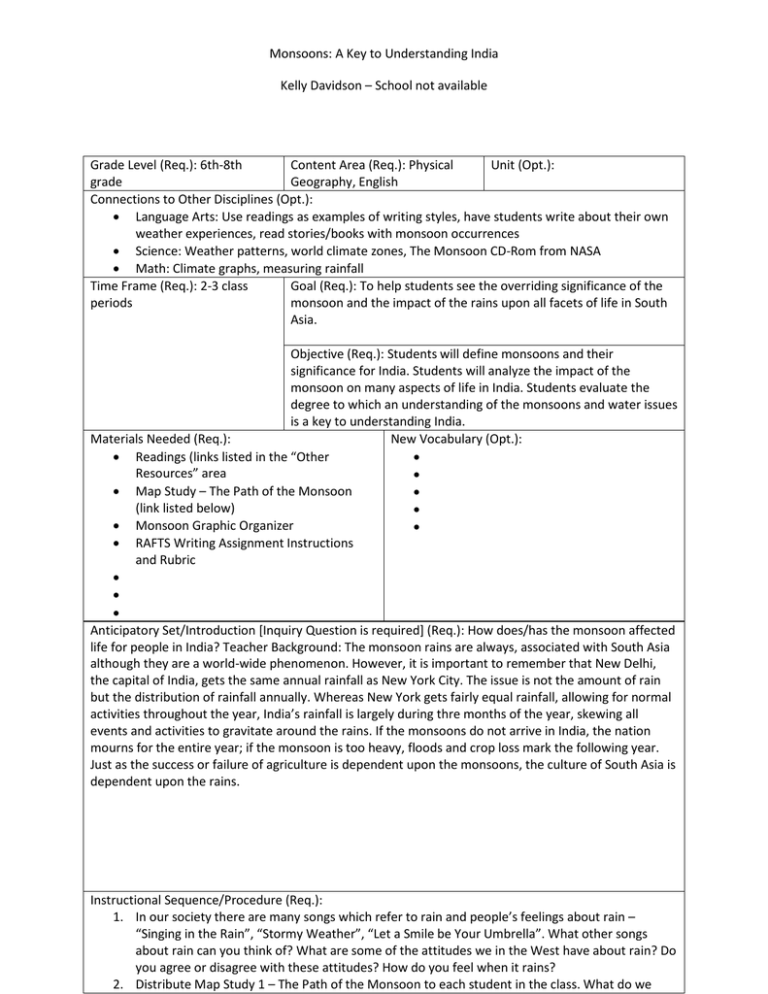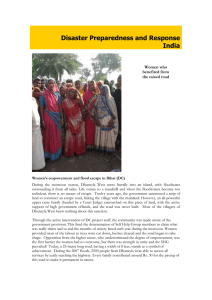Monsoons: A Key to Understanding India Grade Level (Req.): 6th-8th
advertisement

Monsoons: A Key to Understanding India Kelly Davidson – School not available Grade Level (Req.): 6th-8th Content Area (Req.): Physical Unit (Opt.): grade Geography, English Connections to Other Disciplines (Opt.): • Language Arts: Use readings as examples of writing styles, have students write about their own weather experiences, read stories/books with monsoon occurrences • Science: Weather patterns, world climate zones, The Monsoon CD-Rom from NASA • Math: Climate graphs, measuring rainfall Time Frame (Req.): 2-3 class Goal (Req.): To help students see the overriding significance of the periods monsoon and the impact of the rains upon all facets of life in South Asia. Objective (Req.): Students will define monsoons and their significance for India. Students will analyze the impact of the monsoon on many aspects of life in India. Students evaluate the degree to which an understanding of the monsoons and water issues is a key to understanding India. Materials Needed (Req.): New Vocabulary (Opt.): • Readings (links listed in the “Other • Resources” area • • Map Study – The Path of the Monsoon • (link listed below) • • Monsoon Graphic Organizer • • RAFTS Writing Assignment Instructions and Rubric • • • Anticipatory Set/Introduction [Inquiry Question is required] (Req.): How does/has the monsoon affected life for people in India? Teacher Background: The monsoon rains are always, associated with South Asia although they are a world-wide phenomenon. However, it is important to remember that New Delhi, the capital of India, gets the same annual rainfall as New York City. The issue is not the amount of rain but the distribution of rainfall annually. Whereas New York gets fairly equal rainfall, allowing for normal activities throughout the year, India’s rainfall is largely during thre months of the year, skewing all events and activities to gravitate around the rains. If the monsoons do not arrive in India, the nation mourns for the entire year; if the monsoon is too heavy, floods and crop loss mark the following year. Just as the success or failure of agriculture is dependent upon the monsoons, the culture of South Asia is dependent upon the rains. Instructional Sequence/Procedure (Req.): 1. In our society there are many songs which refer to rain and people’s feelings about rain – “Singing in the Rain”, “Stormy Weather”, “Let a Smile be Your Umbrella”. What other songs about rain can you think of? What are some of the attitudes we in the West have about rain? Do you agree or disagree with these attitudes? How do you feel when it rains? 2. Distribute Map Study 1 – The Path of the Monsoon to each student in the class. What do we 3. 4. 5. 6. 7. 8. 9. learn about the monsoon from this map? Why do you think the monsoon comes from the east and the west? As you notice from the map, the color of the monsoon map changes as the monsoon heads north. What do you think this indicates? Which areas of India seem least affected by the monsoon? Most affected? If you were looking for a place to live in India, how would the information on this map affect your decision? Divide class into six groups for Jigsaw cooperative learning lesson. Each group will receive a different readings related to the monsoon. Distribute Readings 1-6. Teacher will place the following question on the chalkboard: “How does/has the monsoon affected life for people in India?” Students should be allowed approximately 15 to 20 minutes to read materials and answer questions. Remind them, it is important to examine the monsoon from many vantage points to really understand why water (the monsoon) is the key to understanding India. Once individuals have read their materials and attempted to answer the question, allow students with identical readings to get together and share their ideas. Discussion should focus on the question. Groups should then prepare a brief presentation to explain their article and how it answers the question. Make materials like maps, overhead projectors, etc. available to them. Hand out copies of the Monsoon Graphic Organizer. Instruct students to fill them in as others present their materials. Make sure they know they can ask questions, if needed. When all presentations are complete, turn the organizer over and discuss the following, how is the monsoon important in each of the following categories? Physically, Psychologically, Culturally, Historically, Environmentally, Artistically. Why can we say that the monsoon (water) is a key to understanding India? At the beginning of the lesson we talked about how we feel when it rains. We all have different attitudes about the rain during different times of the year. Distribute Reading 7 – The Twelve Months of the Very Young Husband. Read the poem aloud with the class. Discuss: How did the young husband in this poem respond to the seasons? How did the wife respond to the seasons? What is the relationship between this poem and the monsoon? Each student will now need to write an essay answering the question, “How does/has the monsoon affected life for people in India?” Students will answer the question in one of the two RAFTS formats given. 10. 11. 12. 13. 14. 15. 16. 17. 18. 19. 20. Formative Evaluation (Req.): Class participation, cooperation, and discussion Assessment (Req.): Monsoon Graphic Organizer, RAFTS Writing Assignment Iowa Core Curriculum Standards Used (Req.): • Geography, grade 6-8: Understand the use of geographic tools to locate and analyze information about people, places, and environments. • Geography, grade 6-8: Understand how human factors and the distribution of resources affect the development society and the movement of populations. • Employability Skills, grade 6-8: Communicate and work productively with others, considering different perspectives, and cultural views to increase the quality of work. • • • • • • • Common Core Curriculum Standards Used (Opt.): • Writing, grade 6-12: Produce clear and coherent writing in which the development, organization, and style are appropriate to task, purpose, and audience. • Speaking and Listening, grade 6-12: Engage effectively in a range of collaborative discussions (one-on-one, in groups and teacher-led) with diverse partners on specific grade level topics, texts, and issues, building on others' ideas and expressing their own clearly and persuasively. • • • NGS Standards Used (Req.): • How to use maps and other geographic representations, tools, and technologies to acquire, process, and report information from a spatial perspective • Analyzing the spatial organization of people, places, and environments in a spatial context • The processes, patterns, and functions of human settlement • • • • • • • Five Themes of Geography Used (Req.): School District Standards and Benchmarks (Opt.): • Place • • Human-Environmental Interaction • • Movement • • • 21st Century Universal Constructs (Opt.): Collaboration Other Disciplinary Standards (Opt.): • • • • • Other Essential Information (Opt.): Other Resources (Opt.): • Reading 1 – What is Monsoon? (http://www.globaled.org/nyworld/materials/india/waterakey1.html); Reading 2 – Keeping Data on the Monsoon (http://www.globaled.org/nyworld/materials/india/waterakey2.html) • • • • Reading 3 – Heat and Crops-The Cycle of the Seasons (http://www.globaled.org/nyworld/materials/india/waterakey3.html); Reading 4 – The Monsoon and Deforestation (http://www.globaled.org/nyworld/materials/india/waterakey4.html) Reading 5 – What to do during a Monsoon (http://www.globaled.org/nyworld/materials/india/waterakey5.html); Reading 6 – The Monsoon Music and Poetry (http://www.globaled.org/nyworld/materials/india/waterakey6.html) Reading 7 – The Twelve Months of the Very Young Husband (http://www.globaled.org/nyworld/materials/india/waterakey7.html); Map Study – The Path of the Monsoon (http://www.globaled.org/nyworld/materials/india/mapMonsoon.html) Water: A Key to Understanding India (http://www.globaled.org/nyworld/materials/india/waterakey.html) THE MONSOON - A Key to Understanding India Graphic Organizer What is a monsoon? What to do in a Monsoon Heat and Crops Monsoons and Deforestation Keeping Data on Monsoons Music and Poetry How is the monsoon important in each of the following categories? Physically Historically Psychologically Environmentally Culturally Artistically RAFTS ASSIGNMENT Your task is to write a poem or letter about monsoons in India. Make sure you use your graphic organizer as a guide. It should be full of great information for you to include. You may chose one of the two RAFTS formats below. Remember to use details and examples. Remember, RAFTS stands for: R = Role A = Audience F = Format T = Theme S = Strong Verb(s) R = Poet A = Poetry lovers in India and the USA F = Poem T = How does / has the monsoon affected life for people in India? S = Describe and explain OR R = American tourist in India during monsoon season A = Family back home in Iowa F = Letter T = How does / has the monsoon affected life for people in India? S = Describe and explain You will be graded on Organization, Conventions, Accuracy, Focus, and Support. See the rubric for more details.








